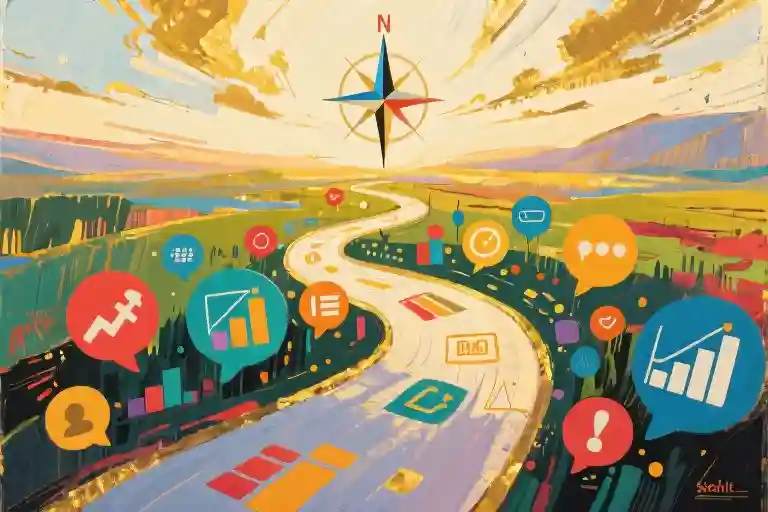The fluorescent lights of my first cubicle still flicker in my memory, casting shadows on the Post-its where I’d scribbled video game character ideas instead of career goals. At 22, I could passionately debate the merits of different 3D modeling software, but ask me about five-year professional plans? I’d suddenly develop an intense fascination with the office coffee machine.
Career planning felt like wearing someone else’s stiff suit – uncomfortable and vaguely fraudulent. There was ambition, sure. I wanted meaningful work, financial independence, and to avoid becoming that person who stares at the clock waiting for 5:01 PM. But the mechanics of getting there? That remained safely tucked away in the ‘adulting’ folder I kept meaning to organize.
My startup job provided the perfect excuse. We were changing the world (or at least our corner of it) at breakneck speed. Who had time for career development when there were product launches and all-night coding sessions? I mistook motion for progress, assuming professional growth would naturally follow professional busyness.
Here’s what I wish someone had told my younger self: Careers don’t automatically evolve like Pokémon. That promotion won’t magically appear because you put in hours. Your manager can’t read your mind about aspirations you haven’t articulated. Without intentional navigation, you’re not sailing toward your dreams – you’re drifting wherever the corporate currents take you.
The most dangerous career myth isn’t about working hard paying off. It’s the assumption that someone else is steering your professional journey. Your company isn’t responsible for your growth. Your manager isn’t your career GPS. That quarterly review form isn’t a development plan. The terrifying and liberating truth? You’re the only constant in your professional story, regardless of job titles or organizational charts.
This realization hit me like a poorly rendered 3D bunny to the face years later. The colleagues who progressed weren’t necessarily smarter or harder working – they understood career development as an active sport, not a spectator activity. They asked uncomfortable questions early. They saw managers as coaches rather than evaluators. They invested in skills that outlasted any single job.
Consider this your intervention if you’re stuck in that same 22-year-old mindset I was. Not the kind with awkward family members and folding chairs, but the kind where we acknowledge career growth requires equal parts strategy and courage. Where we trade ‘someday’ thinking for intentional action. Where we stop waiting for permission to build the professional life we want.
Because here’s the secret no one tells you at orientation: Career ownership isn’t about having all the answers. It’s about asking better questions than ‘When’s my next promotion?’ It’s recognizing that skills compound while job titles expire. It’s understanding that the most successful professionals aren’t those who climb fastest, but those who build ladders that go where they actually want to go.
The Hidden Algorithm of Career Success
At 22, I measured career progress by all the wrong metrics – the fancy title on my business card, the proximity to the CEO’s office, even the thickness of the conference room sandwiches at leadership meetings. It took a decade and three failed startups to understand what really builds lasting career capital.
The Wedding Invitation Fallacy
We often confuse career success with external validation – promotions, awards, or inclusion in exclusive meetings. It’s like equating friendship quality with wedding invitations. You wouldn’t judge your closest relationships by how many ceremonies you’re invited to attend. The deepest bonds often exist outside formal celebrations.
Career growth works the same way. When I mentored Sarah, a brilliant data analyst obsessed with becoming a manager, we reframed her approach: “Instead of chasing the Director title, what skills would make you undeniable for that role?” Within eighteen months of mastering cross-functional leadership and strategic forecasting – skills that outlast any job title – the promotion came unsolicited.
The Coffee Runner Promotion Trap
Early in my career, I witnessed a cautionary tale. Jake, an ambitious associate, dedicated two years to becoming the “go-to” person for administrative tasks – fetching coffee, compiling reports, managing calendars. When his promotion finally came, the new role simply involved supervising more coffee runs. The company collapsed eighteen months later, leaving Jake with a fancy title but no marketable skills in a tech-driven job market.
This mirrors LinkedIn’s 2022 Workforce Learning Report showing 87% of skills become obsolete within five years. The coffee runners who focused solely on pleasing superiors often found themselves stranded when industries shifted. Meanwhile, colleagues who prioritized skill-building – like my former intern who mastered Python during lunch breaks – transitioned seamlessly into higher-value roles.
The Bankruptcy Test
Here’s a thought experiment I use with mentees: If your company went bankrupt tomorrow, what tangible abilities would you take with you? During the 2020 pandemic, employees who passed this test thrived. My friend Marco, a retail manager, had spent nights studying e-commerce platforms. When stores closed, he pivoted to consulting while colleagues waited for reopening notices.
Skills are your career’s permanent assets. Titles and salaries fluctuate with market conditions, but your ability to solve problems, lead teams, or analyze data compounds over time. The most secure professionals don’t climb corporate ladders – they build skill bridges across industries.
Reframing the Promotion Question
Instead of asking “How do I get promoted?” try these skill-focused alternatives:
- “What three abilities would make me irreplaceable in this role?”
- “Which projects would stretch my capabilities while delivering real value?”
- “Who outside my department could benefit from my current skills?”
When Sheryl Sandberg left a senior government role for an unknown startup called Google, she wasn’t chasing titles. She followed opportunities to develop skills at the intersection of technology and policy – a combination that later defined her career. The promotions came because the skills created undeniable value.
Your Career’s True North
External validation makes a terrible compass. The professionals I’ve seen thrive through recessions and industry disruptions all share one habit: They maintain a personal skills dashboard separate from company performance reviews. Every quarter, they add new competencies and identify emerging gaps.
Try this exercise: List three skills that will matter most in your field five years from now. Now audit your current projects – are you actively developing at least one? If not, you might be climbing a ladder leaning against the wrong wall. Remember, in the long arc of a career, skills outlive every job title you’ll ever hold.
Turning Your Manager into Your Career Coach
Early in my career, I operated under a dangerous misconception: that managers were primarily evaluators whose approval needed to be constantly earned. My strategy? Project flawless competence at all costs. I’d smile through confusion, decline help offers with “I’ve got this,” and treat any manager involvement in my work as professional failure. This “perfect employee” act didn’t make me better—it just made me lonely and stagnant.
The Olympian Mindset Shift
What changed everything was realizing elite performers—the very people we admire for their independence—rely most heavily on coaching. Consider:
- Serena Williams has coached with Patrick Mouratoglou since 2012 despite already being world #1
- Michael Phelps worked with Bob Bowman for 20 years through 28 Olympic medals
- Tom Brady still reviews game footage with position coaches at 45
These aren’t crutches; they’re competitive advantages. Your manager holds the playbook for navigating your organization’s specific challenges. When I finally asked my manager, “What would you do in my position?” it unlocked:
- Insider knowledge of unspoken promotion criteria
- Warning signs about upcoming department changes
- Tailored skill-building recommendations
The Feedback Sandwich That Works
Asking for help is a skill itself. Try this three-layer approach:
- Appreciation Layer: “I really value how you handled [specific example] last quarter…”
- Growth Layer: “I’m working on improving [skill]—would you share one opportunity you see for me to practice this?”
- Action Layer: “Could we schedule 15 minutes weekly to review my progress on this?”
This structure:
- Positions feedback as collaborative improvement, not criticism
- Gives managers clear ways to support you
- Creates accountability through scheduled check-ins
From Evaluation to Evolution
The most transformative question I learned to ask: “What would exceptional look like for this role?” This shifts conversations from passive scoring to active roadmap building. One marketing director shared how this question helped her:
- Identify three missing competencies for VP consideration
- Secure company-funded leadership training
- Develop measurable quarterly growth metrics
Remember: Your manager’s success is tied to yours. They’re incentivized to help you grow—if you show them how. The Olympic athletes we admire don’t just train harder; they train smarter with expert guidance. Your career deserves the same advantage.
The Future Self Workshop
Seven years ago, I stumbled upon a life-changing practice almost by accident. While cleaning out my desk, I found an old notebook with a page titled “One Day, I Will…” in embarrassingly enthusiastic handwriting. The date at the top read January 2015. What caught my attention wasn’t the aspirational items (though some made me chuckle), but how many I’d unconsciously accomplished without realizing it.
The Science Behind Your Brain’s Blueprint
Neuroscience reveals something fascinating about our brains: they can’t reliably distinguish between vividly imagined experiences and actual ones. Mirror neurons – those clever little cells responsible for learning through observation – fire the same way whether you’re performing an action or simply visualizing it with precision. This explains why Olympic athletes spend hours mentally rehearsing their routines and why students who visualize exam success often outperform peers with similar abilities.
A 2016 Harvard study demonstrated this phenomenon beautifully. Participants who spent 15 minutes daily visualizing themselves learning piano showed comparable neural changes to those actually practicing the instrument. Your brain essentially creates mental scaffolding for skills before you even begin developing them.
My Evolving “One Day” List (2015-2023)
Here’s how my list transformed over eight years, with commentary on what each milestone taught me:
2015 (Age 28)
- ✓ Speak confidently in team meetings (achieved Q3 2016)
Realization: Confidence came from preparation, not personality - ✗ Lead a cross-functional project (delayed until 2018)
Lesson: Needed to first master stakeholder management
2018 (Career Pivot Year)
- ✓ Transition from IC to management role (promoted Q2 2019)
Key: Asked for stretch assignments 6 months prior - ✓ Give keynote at industry event (checked off 2021)
Surprise: Virtual events lowered initial barrier
2023 (Current Focus)
- ◉ Build fluency in data storytelling
- ◉ Mentor first-time founders
- ◉ Develop conflict resolution framework
Your Turn: The Interactive Workshop
Grab a notebook (digital works too) and let’s build your future self blueprint:
Step 1: Skill Archaeology
List 3 skills you’ve unexpectedly developed in the past 3 years. Mine were:
- Crisis communication (thanks, pandemic)
- Remote team building
- Strategic delegation
Step 2: Future Casting
Complete these prompts:
- “In 3 years, I want to feel comfortable when…”
- “By 2026, people will come to me for help with…”
- “My future self handles [current struggle] by…”
Step 3: Reverse Engineering
Pick one item and break it down:
Example: “Host stress-free large events”
- Month 1-3: Attend 3 events as observer
- Month 4-6: Co-host small gathering
- Month 7-9: Run logistics for medium event
- Month 10-12: Lead full-scale production
Maintenance Mode
Your list is a living document. Schedule quarterly “Future Self Reviews”:
- Celebrate checked items (no achievement too small)
- Prune goals that no longer resonate
- Identify patterns in your growth trajectory
- Adjust timelines without guilt
Pro Tip: Create a “Future Self Playlist” of songs that embody the energy you want to cultivate. Mine includes “Unstoppable” by Sia and “The Climb” by Miley Cyrus – don’t judge.
When Doubt Creeps In
Every December, I experience what I call “Future Self Imposter Syndrome” – that nagging voice saying “Who are you kidding?” Here’s my counterattack:
- Re-read past list versions (perspective is everything)
- Find “before” examples of mastered skills
- Message 3 people who’ve achieved similar goals
- Do one tiny action toward any list item
Remember: This isn’t about rigid goal-setting. It’s about creating a magnetic vision of your evolving capabilities that pulls you forward. The items you check off matter less than the person you become in pursuing them.
Next steps: Save this draft somewhere visible. Set a calendar reminder for your first review in 90 days. Future You will be grateful.
Taking Charge of Your Career Destiny
The 5-Year Retrospective Test
One of the most powerful exercises I’ve discovered for gaining career clarity is what I call the “5-Year Retrospective Test.” Here’s how it works: fast forward five years in your imagination, then look backward to assess whether your current choices align with where you want to be.
Ask yourself:
- What skills will I wish I had invested in today?
- What experiences will I regret not pursuing?
- What relationships will prove most valuable?
- What financial position do I want to be in?
This mental time-travel technique works because it bypasses our present-day anxieties and forces us to confront what truly matters. When I first tried this exercise in 2018, I realized I’d regret not developing my public speaking skills – that realization led me to join Toastmasters, which fundamentally changed my career trajectory.
Building Your Skill Hedge Portfolio
In today’s volatile job market, career resilience comes from developing what Warren Buffett would call a “skill hedge portfolio” – a balanced combination of:
- Core Technical Skills (40%): Your primary expertise that pays the bills today
- Adjacent Capabilities (30%): Skills that complement your core competencies
- Future-Proof Abilities (20%): Emerging skills with long-term relevance
- Passion Projects (10%): Skills you cultivate purely for joy
For example, a marketing professional might balance:
- Core: Digital campaign management
- Adjacent: Data analytics
- Future-proof: AI content strategy
- Passion: Podcast production
This diversified approach ensures you’re never completely obsolete when industry winds shift. During the pandemic, I saw colleagues with narrow skill sets struggle while those who’d invested in adjacent capabilities (like copywriters who learned basic coding) transitioned smoothly.
Crafting Your Personal OKR Framework
Objectives and Key Results (OKRs) aren’t just for companies – they’re powerful tools for personal career navigation. Here’s how to adapt them:
Quarterly Career OKRs
- Objective: Bold, inspirational goal (e.g., “Become confident presenting to executives”)
- Key Results: 3-5 measurable outcomes (e.g., “Deliver 3 team presentations with 80%+ positive feedback”)
- Initiatives: Concrete actions (e.g., “Take improv class every Wednesday”)
My personal OKR dashboard includes:
- Skill acquisition targets
- Relationship-building metrics
- Visibility opportunities
- Compensation benchmarks
What makes this different from typical goal-setting? The quarterly cadence creates natural reflection points, while the measurable key results prevent vague aspirations. When I started tracking my presentation skills this way, my improvement accelerated dramatically because I had clear indicators of progress.
The Career Navigation Toolkit
- Monthly Career Check-Ins (30 minutes):
- Review skill development
- Assess relationship growth
- Evaluate current satisfaction
- Opportunity Radar:
- Internal projects that stretch your abilities
- External trends worth monitoring
- Emerging role models to study
- Decision Filters:
- Does this align with my 5-year vision?
- Will this build valuable skills?
- Does this excite me intellectually?
Remember, career sovereignty isn’t about having all the answers – it’s about consistently asking better questions. The professionals I’ve seen thrive longest aren’t those with perfect plans, but those who’ve built systems for continuous course-correction.
“The best career strategy is one that makes you excited to wake up on Monday morning.”
What one system will you implement this week to take more ownership of your professional journey?
Your Career Launch Sequence
Think of your professional journey like a rocket launch sequence. That moment when the engines ignite and the spacecraft begins its ascent isn’t the result of a single action, but rather hundreds of perfectly timed steps working in harmony. Your career operates on the same principle – each skill mastered, every meaningful conversation with your manager, all those items checked off your “One Day” list represent critical stages in your personal countdown to success.
The Checklist Before Liftoff
Before we hand you the controls, let’s review your pre-launch checklist:
- Navigation Systems Online – You’ve shifted from tracking external validation to mapping skill development
- Coaching Network Engaged – Your managers have transformed from evaluators to mission control specialists
- Visualization Software Active – Your “One Day” list provides clear coordinates for your destination
- Autopilot Disengaged – You’ve taken full command of your trajectory
Download Your Flight Manual
We’ve prepared a customizable “One Day, I Will…” template to serve as your career flight plan. This isn’t just another to-do list – it’s a living document that will evolve as you do. The template includes:
- Skill acquisition timelines
- Manager coaching request scripts
- Progress tracking dashboards
- Quarterly self-assessment prompts
Download Your Career Flight Plan Template (PDF/Google Docs versions available)
Initiate Launch Sequence
Here’s your final mission briefing:
- T-30 Days: Share one item from your “One Day” list with your manager this week
- T-15 Days: Identify one skill that will increase your impact (not your title)
- Liftoff: Schedule a recurring calendar reminder to review your flight plan quarterly
Transmission from Mission Control
As you prepare to throttle up, remember what we’ve learned together:
- Career capital compounds – The skills you build today will open doors you can’t yet see
- Coaching creates velocity – Every great achiever has guides who helped them navigate
- Vision determines altitude – The clearer your destination, the straighter your path
Your career spacecraft is fueled and ready. The countdown clock is ticking:
10… You’ve got the tools
9… You understand the principles
8… You’ve identified your coordinates
7… You know how to course-correct
6… You’ve got a support team
5… You’re tracking meaningful metrics
4… You’re developing valuable skills
3… You’re building lasting impact
2… You’re creating your future
1…
What’s the first mission your “One Day” list will tackle? Comment below or tweet us @CareerLaunch with #MyCareerMission





